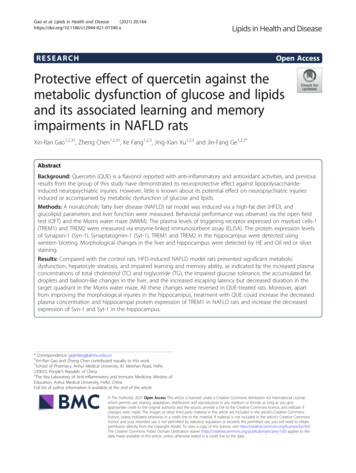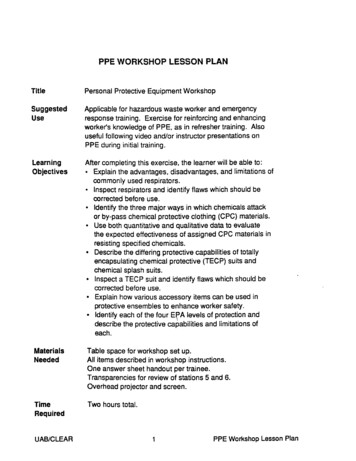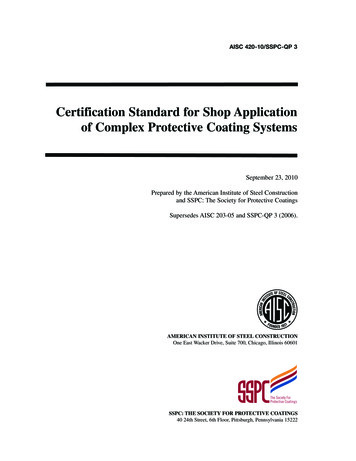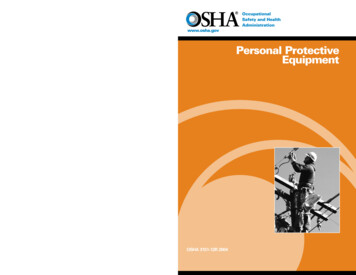
Transcription
Gao et al. Lipids in Health and Disease(2021) SEARCHOpen AccessProtective effect of quercetin against themetabolic dysfunction of glucose and lipidsand its associated learning and memoryimpairments in NAFLD ratsXin-Ran Gao1,2,3†, Zheng Chen1,2,3†, Ke Fang1,2,3, Jing-Xian Xu1,2,3 and Jin-Fang Ge1,2,3*AbstractBackground: Quercetin (QUE) is a flavonol reported with anti-inflammatory and antioxidant activities, and previousresults from the group of this study have demonstrated its neuroprotective effect against lipopolysaccharideinduced neuropsychiatric injuries. However, little is known about its potential effect on neuropsychiatric injuriesinduced or accompanied by metabolic dysfunction of glucose and lipids.Methods: A nonalcoholic fatty liver disease (NAFLD) rat model was induced via a high-fat diet (HFD), andglucolipid parameters and liver function were measured. Behavioral performance was observed via the open fieldtest (OFT) and the Morris water maze (MWM). The plasma levels of triggering receptor expressed on myeloid cells-1(TREM1) and TREM2 were measured via enzyme-linked immunosorbent assay (ELISA). The protein expression levelsof Synapsin-1 (Syn-1), Synaptatogmin-1 (Syt-1), TREM1 and TREM2 in the hippocampus were detected usingwestern blotting. Morphological changes in the liver and hippocampus were detected by HE and Oil red or silverstaining.Results: Compared with the control rats, HFD-induced NAFLD model rats presented significant metabolicdysfunction, hepatocyte steatosis, and impaired learning and memory ability, as indicated by the increased plasmaconcentrations of total cholesterol (TC) and triglyceride (TG), the impaired glucose tolerance, the accumulated fatdroplets and balloon-like changes in the liver, and the increased escaping latency but decreased duration in thetarget quadrant in the Morris water maze. All these changes were reversed in QUE-treated rats. Moreover, apartfrom improving the morphological injuries in the hippocampus, treatment with QUE could increase the decreasedplasma concentration and hippocampal protein expression of TREM1 in NAFLD rats and increase the decreasedexpression of Syn-1 and Syt-1 in the hippocampus.* Correspondence: gejinfang@ahmu.edu.cn†Xin-Ran Gao and Zheng Chen contributed equally to this work.1School of Pharmacy, Anhui Medical University, 81 Meishan Road, Hefei230032, People’s Republic of China2The Key Laboratory of Anti-inflammatory and Immune Medicine, Ministry ofEducation, Anhui Medical University, Hefei, ChinaFull list of author information is available at the end of the article The Author(s). 2021 Open Access This article is licensed under a Creative Commons Attribution 4.0 International License,which permits use, sharing, adaptation, distribution and reproduction in any medium or format, as long as you giveappropriate credit to the original author(s) and the source, provide a link to the Creative Commons licence, and indicate ifchanges were made. The images or other third party material in this article are included in the article's Creative Commonslicence, unless indicated otherwise in a credit line to the material. If material is not included in the article's Creative Commonslicence and your intended use is not permitted by statutory regulation or exceeds the permitted use, you will need to obtainpermission directly from the copyright holder. To view a copy of this licence, visit http://creativecommons.org/licenses/by/4.0/.The Creative Commons Public Domain Dedication waiver ) applies to thedata made available in this article, unless otherwise stated in a credit line to the data.
Gao et al. Lipids in Health and Disease(2021) 20:164Page 2 of 15Conclusions: These results suggested the therapeutic potential of QUE against NAFLD-associated impairment oflearning and memory, and the mechanism might involve regulating the metabolic dysfunction of glucose andlipids and balancing the protein expression of synaptic plasticity markers and TREM1/2 in the hippocampus.Keywords: NAFLD, Quercetin, TREM1/2, Glucose and lipids metabolism, Central nervous system, Cognitive functionBackgroundNonalcoholic fatty liver disease (NAFLD) is a chronicliver injury characterized by excessive intrahepatic fat accumulation without increased alcohol consumption orother causes of liver steatosis. Due to alterations in lifestyle and the increasing incidence of obesity, the prevalence of NAFLD is increasing worldwide. In China,NAFLD has been reported to be the second most common liver disease following viral hepatitis [1]. Moreover,apart from metabolic dysfunction and liver injuries,which are the main clinical manifestation of NAFLD, anincreasing incidence of neuropsychiatric diseases, including cognitive dysfunction [2] and depression [3], are reported in NAFLD patients, together with decreasedbrain volume and pathological changes [4]. The resultsof animal studies have also demonstrated oxidative stressand disturbances of neurotransmitter activities in thebrains of NAFLD rats [5]. In line with these findings,HFD-induced NAFLD rats presented not only metabolicdysfunction, including obesity, dyslipidemia, glucosemetabolic dysfunction, and liver dysfunction but also behavioral performance of impaired learning and memory[6], although the mechanism remains unclear. These results suggested a close association between NAFLD andneuropsychiatric impairments [7]. Thus, it is imperativeto further investigate the pathogenesis of NAFLD andexplore potential therapeutic drugs with high efficacyand few side effects.Hyperlipemia, together with its resulting or accompanied insulin resistance, has been considered an importantrisk factor triggering neuropsychiatric injuries in metabolic diseases, including diabetes mellitus and NAFLD.Cholesterol is a component of neuronal cell membranesin the brain, and glucose is an important energy sourcefor the brain. Dysfunction of glucose and lipid metabolism can affect the normal transmission of signal molecules between synapses and lead to learning andmemory impairment and cognitive disorder [8]. It hasbeen demonstrated in animal research that hyperinsulinemia, especially elevated serum cholesterol and triglyceride levels, are negative factors that are closely relatedto the cognitive performance of rats in the MWM task[9] or the novel object recognition (NOR) test [10].Moreover, sitagliptin (STG), a common antidiabetic drugtargeting glucagon-like peptide-1 (GLP-1) signaling viadipeptidyl peptidase 4, is reported not only to improveglucose and lipid metabolism disorders but also to havea protective effect on neuropsychiatric injuries in diabetes mellitus [11] patients or HFD mice [12]. Thus, theregulation of glucose and lipid metabolism might be afundamental treatment for NAFLD and its associatedneuropsychiatric injury.Synaptic plasticity plays a vital role in maintaining normal brain structure and functions [13], and a decreasedabundance of synaptic proteins has been identified to beinvolved in the pathophysiology of neuropsychiatric diseases, including mild cognitive impairment, Alzheimer’sdisease (AD), and depression [14, 15]. Synaptotagmin-1(Syt-1) and Synapsin-1 (Syn-1) are crucial synapticassociated proteins for vesicle fusion, neurotransmitterrelease, and synaptic transmission [16, 17]. In the previous study, imbalanced expression of Syn-1 and Syt-1was presented in the hippocampus and prefrontal cortex(PFC) in chronically stressed [18, 19] or subclinicalhypothyroidism (SCH) suffering rats [20] and was significantly correlated with depression-like behaviors andimpaired learning and memory. Consistently, decreasedSyt-1 levels have also been found in the hippocampus ofrats that experienced chronic stress or long-term corticosterone administration [21, 22]. However, little isknown about their roles in NAFLD-associated neurobiological injuries.The triggering receptors expressed on myeloid cells(TREMs) are members of the immunoglobulin family[23], with the main pathophysiological function in regulating inflammatory and immune responses. In recentyears, much research has focused on the role ofTREM1/2 in neuropsychiatric diseases, including AD, although the results have not always been consistent [24–26]. Mounting evidence has demonstrated that manypathological conditions can alter the balance in TREMexpression, resulting in separate outcomes from distinctdiseases [27]. Consistently, carried out by the samegroup of this study, the results of a previous study demonstrated behavior-related variations in the hippocampalabundance of TREM2 between rats aged 2 months and6 months. Moreover, decreased expression of TREM1but increased expression of TREM2 were also demonstrated in the hippocampus and PFC of rats challengedwith lipopolysaccharide (LPS), accompanied bydepression-like behaviors and impairment of learningand memory [28]. In addition, an imbalance of TREM1and TREM2 has also been reported to be involved in thepathological process and therapeutic outcome of
Gao et al. Lipids in Health and Disease(2021) 20:164nonalcoholic steatohepatitis (NASH) [29]. These resultssuggest that the abundance or function of TREM1 andTREM2 might be one of the potential targets for improving NAFLD, not only the metabolic dysfunction ofglucose and lipid and liver injuries but also neuropsychiatric impairments.Querctin (QUE) is a flavonol derived from diverseplants. It has been reported that QUE could ameliorateglucose tolerance and reduce serum concentrations ofinsulin, low-density lipoprotein cholesterol (LDL), andtriacylglycerol in HFD rats [30]. Targeting its neuroprotective effect, the results of a previous study showed thatQUE could bind to mono- or fibril amyloid beta and alleviate LPS-induced depressive behaviors and impairedlearning and memory in rats [28], which was in line withthe findings of other studies [31]. These results indicatedthat QUE might be a good strategy for therapeutic intervention against NAFLD, targeting both metabolic dysfunction and behavioral impairments.The purpose of the present study was to investigatethe potential effect of QUE against metabolic and neuropsychiatric injuries in NAFLD and explore the possiblemechanism. An NAFLD rat model was established viaHFD, and plasma glucose and lipid concentrations andliver function were measured. Behavioral performancewas examined using the open field test (OFT) and theMorris water maze (MWM). Morphological changes inthe liver and hippocampus were detected through HE,Oil red, or silver staining. Moreover, the protein expression levels of syt-1, syn-1 and TREM1/2 in the hippocampus were measured using western blotting.Materials and methodsDrugsQUE was purchased from Sigma Chemical Co. (Louis,MO, USA). Sitagliptin phosphate was produced byMerck Sharp Dohme Ltd. (New Jersey, USA). Donepezilhydrochloride was produced by Jiangsu Haosen Pharmaceutical Co., Ltd. (Jiangsu, China). All the drugs weredissolved in 0.5% sodium carboxymethyl cellulose aqueous solution to make a mixed suspension.Animals and groupsSixty-four Sprague–Dawley (SD) male rats (aged 2months) were purchased from the experimental animalcenter of Anhui Medical University (Anhui, China).They were fed under ambient temperature conditions of21–22 C and 50–60% relative humidity with a commutative 12 h light/dark schedule. All animal care practicesand experimental procedures were approved by the Animal Care and Use Committee of Anhui Medical University in compliance with the National Institutes of HealthGuide for the Care and Use of Laboratory Animals (NIHpublication No. 85–23, revised 1985).Page 3 of 15After 1 week of acclimatization, the rats were randomly divided into eight groups, including the controlgroup (CON), CON QUE (40 mg/kg) group, NAFLDgroup, NAFLD QUE (80, 40, or 20 mg/kg) group, NAFLD STG (sitagliptin, 10 mg/kg) group, and NAFLD DNP(donepezil, 1 mg/kg) group, with 8 rats in each of groupsand 4 rats per cage, access to food and water at liberty.The diets fed to the rats were as described in a previousstudy [6]. Briefly, the rats in the CON and CON QUEgroups were administered a standard diet (3601 kcal/kg;Trophic Animal Feed High-Tech Co., Ltd., Nantong,China), and rats in other groups were given a high-fatdiet (5000 kcal/kg; Trophic Animal Feed High-Tech Co.,Ltd., Nantong, China). Food consumption was measuredevery day and change in body weight was measuredevery week. The energy consumption of rats in the CONand CON QUE groups was calculated by the food consumption 3.601 kcal, and rats in other groups were calculated by the food consumption 5.000 kcal. After 4weeks, QUE, STG and DNP were administered intragastrically for 4 weeks. Rats in the control and untreatedNAFLD groups received the corresponding volume of0.5% sodium carboxymethyl cellulose via the same route.The outline of the experimental design is shown inFig. 1.Behavioral testsAll behavioral tests were performed according to a previous study [6], with test time matched between groups.Before each test, all the animals were given an adaptivetime of 30 min to the testing environment, and the observers were blinded to the group arrangement. A digitalcamera interfaced with a computer equipped with ANYmaze video imaging software (Stoelting Co, Wood Dale,USA) was used to monitor and record the behavioralperformance.Open-field test (OFT)The OFT experimental apparatus is composed of a 100cm square field, and the floor is divided into 16 smallsquares with equal grids. The device is surrounded by a30 cm high wall, and the entire device is black. Duringthe test, each rat was placed in a corner of the apparatusfacing the wall and allowed to move free for 5 min. Thefrequencies of rearing, grooming and defecation were recorded for statistical analysis.Morris water maze (MWM) testThe circular black pool for the Morris water maze is180 cm in diameter and 50 cm in height, and there areseveral large visual cues constantly surrounding the tankat a height of 120–150 cm. Before the test, the pool wasfilled with water to 40 cm high, and the water was dyedblack with an edible pigment. A circular escape platform
Gao et al. Lipids in Health and Disease(2021) 20:164Page 4 of 15Fig. 1 Outline of the experimental design for nonalcoholic fatty liver disease (NAFLD) and behavioral testswas hidden 1 cm under the surface of the water. The circular water surface was divided into four equal quadrants, and the quadrant where the escape platform waslocated was defined as the target quadrant.The task consisted of a 3-day acquisition phase with4 massed trials administered each day and a 1-dayprobe phase on the 4th day. During the acquisitionphase, the platform was invisible and constant, andthe 4 start locations were distributed north, south,east and west, located at equal distances from eachother on the pool rim. Each rat was placed in thewater facing the wall atone random start location andallowed to find the submerged platform within 60 sand rest there for 30 s; then, the next trial began. Ifthe rat failed to find the hidden platform within 60 s,it was guided to the platform and allowed to remainthere for 30 s. The procedure was repeated for allfour start locations, and the escape latency (latency tofind the platform) was recorded.On the 4th day, the platform was removed, and theprobe test was performed to assess memory retention.Each rat was put into the pool from the diagonally opposite side of the previous platform and allowed to explore the environment for 60 s ad libitum. The durationspent in the target quadrant in the probe test wereanalyzed.Intraperitoneal glucose tolerance test (IGTT)After fasting and water prohibition for 12 h, each rat wasgiven an intraperitoneal injection of glucose at a dose of2.0 g/kg. Tail tip blood was collected before injectionand 15, 30, 60 and 120 min after injection, and a Rocheglycemic meter was used to measure the blood glucoseconcentration.Measurement of the plasma concentrations of TC, TG,sTREM1, and sTREM2Twenty-four hours after the MWM test, the rats werefasted overnight and deeply anesthetized with chloral hydrate. Blood samples were drawn from the abdominalaorta and centrifuged at 3000 rpm for 30 min at 4 C.The plasma concentrations of total cholesterol (TC) andtriglyceride (TG) were detected by Adicon Medical Laboratory Center (Adicon clinical laboratories, LTD,Hefei, China) using chemiluminescence kits (NanjingJiancheng Bioengineering Institute, Nanjing, China). Theplasma levels of sTREM1 and sTREM2 were measuredvia commercially available enzyme-linked immunosorbent assay (ELISA) kits (sTREM1 and sTREM2: HuameiBiotech. Co., LTD, Wuhan, China) according to themanufacturers’ instructions.Measurement of the liver index and histological changesAfter the blood was collected, the liver was dissectedand weighed, and the liver index was calculated by theliver weight/100 g body weight. Then, four rats fromeach group were randomly selected, and the same partsof the livers were collected and fixed in 4% neutralbuffered formalin. After dehydration with graded ethanol, the livers were embedded in paraffin and cut into4 μM thick sections. The sections were stained withhematoxylin and eosin (HE staining) or 0.5% oil red O(oil red O staining) at room temperature. Photomicrographs were captured with an IX51 microscope (Olympus Corporation, Tokyo, Japan).Measurement of the histological changes in thehippocampusFour rats in each group were randomly selected, and thewhole brain was collected, fixed with 4% neutral-
Gao et al. Lipids in Health and Disease(2021) 20:164buffered formalin, embedded in paraffin, sectioned at athickness of 4 μM, and stained with hematoxylin andeosin (HE staining) and silver nitrate (silver staining) according to the regular procedure. Briefly, silver stainingwas conducted as follows: the tissue was circled with animmunohistochemical pen, then 5% silver nitrate wasdropped onto the tissue and reacted with wet box for 20min; then prepared silver ammonia solution drops onthe tissue and soaked in dilute ammonia water; the developer was prepared and reacted with the tissue for approximately 5 min until the nerve fibers appeared black.Photomicrographs were captured with an IX51 microscope (Olympus Corporation, Tokyo, Japan).Page 5 of 15ResultsQUE alleviated hyperglycemia, hyperlipemia,hepatomegaly, and hepatocyte steatosis in NAFLD ratsFigure 2 shows the changes in food consumption(Fig. 2a), energy consumption (Fig. 2b), and body weight(Fig. 2c) in all the groups. Although the quantity of foodWestern blottingThe hippocampus from the other four rats in eachgroup were rapidly dissected, frozen in liquid nitrogen, and stored at 80 C. The tissues were homogenized in radioimmunoprecipitation assay (RIPA)buffer (Beyotime Biotechnology, Shanghai, China).Prior to homogenization, protease inhibitor cocktail(Sigma, St. Louis, MO, USA) and phosphatase inhibitor PhosSTOP (Roche, Indianapolis, USA) was added.Protein was quantified via a Lowry Protein Assay Kit(Meiji Biotech. Co., LTD, Shanghai, China). A total of50 μg protein from each sample was loaded, separatedvia 12% SDS–PAGE gels, and then transferred toPVDF membranes (Millipore, IPVH00010). Afterblocking with 5% skim milk for 2 h, the membranewas incubated with the corresponding antibodies targeting synapsin-1 (1:1000, Immunoway, Newark, DE,USA), synaptotagmin-1 (1:1000, Immunoway, Newark,DE, USA), TREM1 (1:1000, Abcam, Cambridge, UK),TREM2 (1:1000, Abcam, Cambridge, UK) or β-actin(1:1000, Zhongshan Biotechnology, Inc., Beijing,China) at 4 C overnight. Subsequently, the membranes were processed with appropriate HRPconjugated secondary antibodies (1:5000, ZhongshanBiotechnology, Inc., Beijing, China) with regard to theproteins of interest at room temperature for 1 h. Theprotein levels were analyzed using ImageJ (WayneRasband, National Institutes of Health, USA) and normalized relative to that of the internal control βactin.Statistical analysisAll statistical analyses were performed using SPSS (Statistical Package for the Social Sciences, version 17.0.1,SPSS Inc., Chicago, IL, USA). Data are expressed as themean SEM., and P 0.05 was considered statisticallysignificant. Statistical analysis between groups was conducted by one-way analysis of variance (ANOVA)followed by the LSD post hoc test.Fig. 2 Effect of QUE on the food consumption, energy consumptionand body weight of NAFLD rats. The data are presented as the mean SEM, with 8 rats in each of the groups. The NAFLD model rats showedless food consumption (a) but greater energy consumption (b) andgreater body weight (c) than the control or CON QUE rats. However,treatment with QUE (80, 40, or 20 mg/kg) had no significant effect onthese changes. *P 0.05 and **P 0.01 compared with the control group.#P 0.05 and ##P 0.01 compared with the NAFLD model group
Gao et al. Lipids in Health and Disease(2021) 20:164consumption in the NAFLD model group was less thanthat of the controls, the energy consumption and bodyweight gain were both significantly increased. However,there was no significant difference between the NAFLDmodel group and the QUE-, STG-, or DNP-treatedgroups with regard to food consumption, energy consumption, and body weight.Compared with those in the control group, the plasmaconcentrations of TC (Fig. 3a) and TG (Fig. 3b) weresignificantly increased in the NAFLD group. There wasno significant difference between the CON and CON QUE groups. However, the plasma concentrations of TC(Fig. 3a) and TG (Fig. 3b) were remarkably decreased inthe QUE-, STG-, or DNP-treated group compared withthe NAFLD model group. As shown in Fig. 3c and d, theblood glucose levels of 15-, 30- and 60-min after intraperitoneal injection of glucose in the IGTT were remarkably increased in the NAFLD rats as comparedwith those of the control and CON QUE groups. Treatment with QUE also improved the impaired glucose tolerance of NAFLD rats.Page 6 of 15Figure 4a shows the macroscopic and microscopichistological changes in the livers of all the groups. Compared with that of the control group, the livers of theNAFLD rats appeared yellow or pale, greasy, and brittle.The results of HE and oil red staining revealed aggregation of inflammatory cells and numerous lipid dropletsin the livers of NAFLD rats, which was lightened in theNAFLD QUE group. As shown in Fig. 4b, the liverindex were also increased in the NAFLD group compared with the control group. Treatment with QUE reversed the increase of liver index.QUE improved the impaired learning and memory abilityof NAFLD ratsFigure 5 shows the performance of rats in the behavioraltasks. In the OFT, there was no significant differenceamong groups in the rearing frequency, grooming frequency or defecation frequency (Fig. 5a).In the MWM task, the escape latency of all the rats inthis study declined gradually in the acquisition phase(Fig. 5b), indicating that all rats could fulfill the learningFig. 3 Effect of QUE on the plasma concentrations of TC and TG and IGTT in NAFLD rats. The data are presented as the mean SEM, with 8 ratsin each of the groups. Compared with the control and CON QUE rats, the NAFLD group showed increased plasma TC (a) and TG (b) levels, andtreatment with QUE decreased the plasma concentrations of TC and TG. Treatment with QUE also improved the impaired glucose tolerance ofNAFLD rats (c, d). *P 0.05 and **P 0.01 compared with the control group. #P 0.05 and ##P 0.01 compared with the NAFLD model group
Gao et al. Lipids in Health and Disease(2021) 20:164Page 7 of 15Fig. 4 Effect of QUE on macroscopic and histological liver changesin NAFLD rats. The data are presented as the mean SEM, with 8rats in each of the groups. The livers of the NAFLD rats appearedyellow or pale, greasy, and brittle. Inflammatory cells and numerouslipid droplets were detected in the livers of NAFLD rats via HEstaining. The macroscopic and histological liver changes in the QUEtreated group were significantly decreased. Compared with thecontrol and CON QUE rats, the NAFLD group also showedincreased liver index (b), and treatment with QUE reversed theincrease in the variables. **P 0.01 compared with the controlgroup. #P 0.05 and ##P 0.01 compared with the NAFLDmodel grouptask. However, NAFLD rats spent a longer time findingthe submerged platform than did the control or CON QUE rats on all 3 days. In the probe test (Fig. 5c), theduration in the target quadrant of the NAFLD rats wasremarkably less than that of the control and CON QUErats. However, these impairments were reversed by treatment with QUE.QUE alleviated morphological injury in the hippocampusof NAFLD ratsFigure 6 shows typical HE and silver staining graphs ofthe CA1, CA3, and DG regions of the hippocampus ineach group. The results of HE staining showed that theneurons in the hippocampus of the control and CON QUE groups presented with regular shapes and compactarrangements, round and large nuclei, clearly visible nucleoli, and no deep staining of neurons in the sections.However, in the model group, the neuronal cells in eachdistrict were irregular and loosely arranged, and the cellmorphology was atrophic and hyperchromatic, with unclear boundaries of nuclei and cytoplasm (Fig.6a to 6c).Silver staining showed that compared with the controland control QUE groups, the nerve cells and nerve fibers of the model group were dyed black, which suggested neuronal damage in the model group (Fig. 6d to6f). The morphological structure of the hippocampus inthe NAFLD rats treated with QUE was similar to that ofthe normal rats.QUE balanced the protein expression of Syn-1 and Syt-1in the hippocampus of NAFLD ratsAs shown in Fig. 7, compared with that in the controlgroup, the protein expression of Syn-1 (Fig. 7b) and Syt1 (Fig. 7c) was decreased in the hippocampus of NAFLDrats. Treatment with QUE imbalanced the protein expression of Syn-1 and Syt-1 in the hippocampus.QUE balanced the abundance of TREM1 in the blood andhippocampus of NAFLD rats, but TREM2 was balancedonly in the hippocampusFigure 8 shows the abundance of TREM1 and TREM2in the plasma and hippocampus of rats in all the groups.
Gao et al. Lipids in Health and Disease(2021) 20:164Page 8 of 15Fig. 5 Effect of QUE on the behavioral performance of NAFLD rats in the OFT and MWM. The data are presented as the mean SEM, with 8 ratsin each of the groups. In the OFT, there was no significant difference among groups with respect to the frequency of rearing, grooming ordefecation (a). In the MWM, the escape latency of the NAFLD rats was longer than that of the control or CON QUE rats on all 3 days of theacquisition phase (b). In the probe trial, NAFLD rats spent less time than control or CON QUE rats in the target quadrant (c). These abnormalitiescould be reversed by treatment with QUE. **P 0.01 compared with the control group. #P 0.05 and ##P 0.01 compared with the NAFLDmodel groupCompared with that in the control group, the proteinexpression of TREM1 (Fig. 8b) was decreased but that ofTREM2 (Fig. 8c) was increased in the hippocampus, andtreatment with QUE reversed the imbalanced expressionof TREM1 and TREM2. Consistently, the plasma concentrations of TREM1 (Fig. 8d) in the model group wereremarkably lower than those in the control or CON QUE groups, and treatment with QUE reversed thechanges in TREM1. However, there was no significantdifference among the groups in the plasma concentration of TREM2 (Fig. 8e).DiscussionThe results of the present study showed that administration of QUE could exert a therapeutic effect againstNAFLD in rats, not only including glucose and lipid metabolism disorders and liver injuries but also impairedlearning and memory. The mechanism might be associated with its ability to improve lipid metabolism,regulate synaptic plasticity, and balance the abundanceof TREM1 and TREM2. Figure 9 shows the summary ofthe therapeutic effect of QUE against the metabolic dysfunction and cognitive impairments of NAFLD modelrats.Hyperglycemia, hyperlipidemia, and liver dysfunctionare the main clinical manifestations of NAFLD. Consistent with previous findings [6], the plasma concentrationsof TG and TC in rats fed a high-fat diet were remarkablyincreased in this study, together with obesity, impairedglucose tolerance, hepatomegaly, hepatocyte steatosis,and liver dysfunction. These results again indicated thecausal link between diet and metabolic disorders andthat a high-fat diet could be used in establishing NAFLDanimal models.Sitagliptin (STG) is a representative DPP-4 inhibitorand is widely used in treating type 2 diabetes mellitus(T2DM) [32]. Considering the important role of glucosemetabolism in maintaining homeostasis and body
Gao et al. Lipids in Health and Disease(2021) 20:164Page 9 of 15Fig. 6 Effect of QUE on morphological injury in the hippocampus of NAFLD rats. (a c) show the HE staining results, and (d f) show the silverstaining results. The neuronal cells of the NAFLD rats were irregular and loosely arranged, and the cell morphology was atrophic andhyperchromatic, with unclear boundaries of nuclei and cytoplasm. The morphological structure of the hippocampus in the NAFLD rats treatedwith QUE was similar to that of the normal ratsfunction, the role of STG has been explored gradually. Ithas been reported that STG could not only improve glucose and lipid metabolic disorders [33, 34] but also alleviate cognitive impairments [35] in NAFLD and T2DMpatients. Hence, STG was selected as a positive controldrug in the present study dosing according to the dosetranslation formula based on body surface area, and theresults showed that STG (10 mg/kg) could significantlyreverse the metabolic dysfunction and liver injury ofNAFLD rats. Similar to the effect of STG, QUE (80, 40,20 mg/kg) also restored the increased plasma TG andTC concentrations of NAFLD rats to normal, accompanied by the improvement of glucose
D STG (sitagliptin, 10mg/kg) group, and NAFLD DNP (donepezil, 1mg/kg) group, with 8 rats in each of groups and 4 rats per cage, access to food and water at liberty. The diets fed to the rats were as described in a previous study [6]. Briefly, the rats in the CON and CON QUE groups were administered a standard diet (3601kcal/kg;










